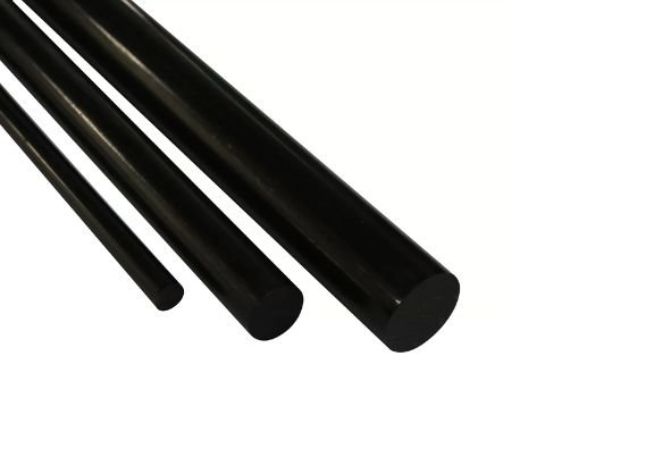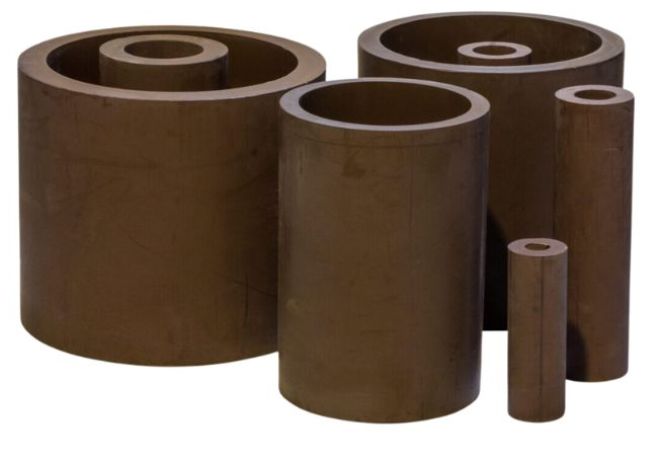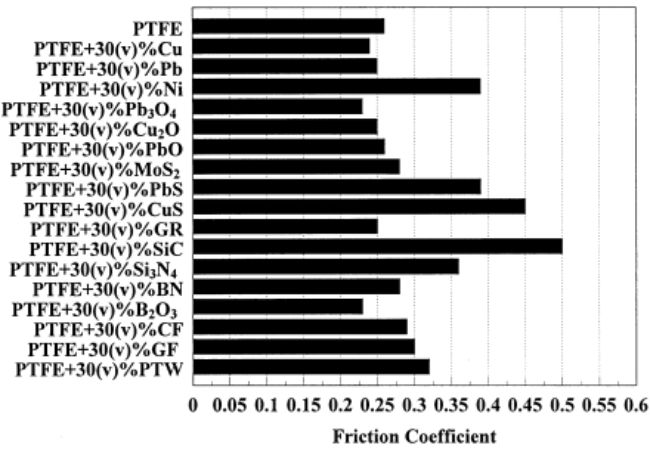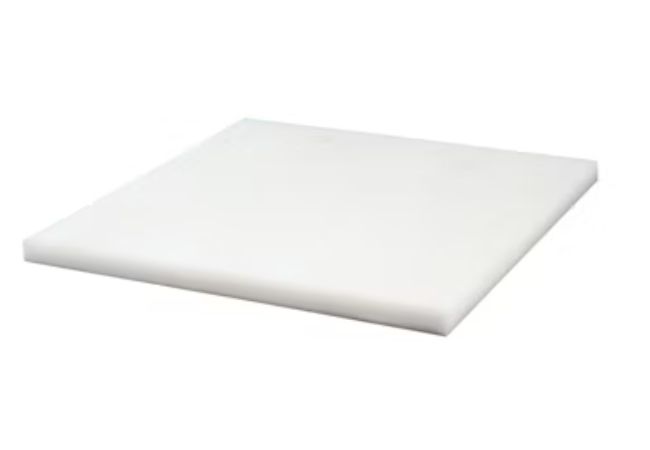PTFE Types by Geometrical Configurations
1. PTFE Sheets
PTFE sheets function as a high-performance engineering material. It comes designed in unique thicknesses and sizes that mostly ranges from 6 – 150 mm. Furthermore, these sheets have the following key properties:
- Good electrical insulating properties.
- Friction coefficient is very low
- Approved by the FDA
- Non-stick
- Aging resistant (UV-resistant)
- Chemically resistant
- Working temp from -190°C – +260°C
- Is not hygroscopic or water absorption of ˂0.01%.
- Highly resistant to gases, fuel, oil, and other chemicals.
- Higher fatigue resistance
Applications of Teflon Sheets
- They are used for electrical insulation works.
- Used for making gaskets, washers, rings, chemical tanks, and vessel linings – all in the chemical industry.
- Can be used as electrical cords.
- Ideal for wire wrapping purposes.
- For making pipes in the petroleum and chemical industries.
- Used as a thread seal tape in the construction industry for plumbing works.
2. PTFE Rods
PTFE rods, commonly known as Teflon rods, are designed unique. They come in different sizes and lengths to meet different production and user needs. These rods are formed using the plunger extrusion procedure.
These rods come with the following general properties:
Mechanical Properties
- Shore hardness at 55
- 220% Elongation at break
- Compression strength of 5 mpa
- Tensile strength of 22 mpa
- Coefficient of friction stands at 0.1%.
Thermal Properties
- Thermal expansion of 13 10-5*1/K
- 260°C Service temperature at short term
- 260°C service temperature at long term
- 20°C Glass transition temperature
- 0.20 W/(k*m) of Thermal conductivity.
- Flammability of V0
Electrical Properties
- Dielectric strength of 80 kV/mm
- Volume resistivity of 1017 O*cm
- Dielectric constant of 2.1
- Surface Resistivity 1016O
Physical Properties
- Easy to cut using die cutting procedure.
- Easily machinable.
- Water absorption of 0.01%
Chemical Properties
- Resistance to most solvents and chemicals.
- Resistance to aging. Even when exposed to the sun for long periods, it doesn’t age.
Applications of Teflon Rods

Teflon rods come in two types which are molded and pressed rods. They can be found used in mechanical, chemical, construction, medical, and electrical industries to make the following:
- Insulators and rollers
- Gaskets / seals
- Slide bearings
- Rings
- Pipe and tube linings.
- Electrical insulation
- Pipes, pipe fittings, pumps, and valves.
- Distillation tower linings
- Beakers, sterilization filters, lung devices, artificial heart devices, etc.
3. PTFE Tubes
PTFE tubes or pipes are versatile pipes designed to come in different sizes and lengths. These tubes are made in different forms such as the multi-lumen, the heat shrinkable, the split, and the filled.
These tubes come with the following unique properties:
- Has good heat resistance.
- Chemically resistant.
- Melting point of 327°C.
- Chemically inert.
- Chemically stable from temperatures ranging from -200°C to 260°C without degrading.
- Its coefficient of friction very low
- Good flexibility or flexural strength, even when used in areas with low temperatures.
- Has high density of 2200kg/m3.
- Good UV resistance
Applications of Teflon Tubes

- In the chemical industry, they are used in pharmaceutical production plants.
- Cosmetic hoses, though are used in cosmetic manufacturing plants.
- Aseptic hoses are used for fluid transfer of high purity.
- Heated hoses are used in transferring hot fluids at a stable temperature.
- In the railways and automotive industry, they are used in making fuel hose, coolant hose, motor bike brake hose, motorsports hose, diesel engine hose, power steering hose, etc.
- Bushings, etc.
They are used in other industries like the electrical industries, chemical processing industries, etc.
4. PTFE Gaskets
PTFE gaskets are easily recognized due to its white color. Due to their flexible and formable nature, they are used in different industries.
Some properties of these gaskets include:
- Good chemical resistance.
- Is able to work efficiently at the temperatures from cryogenic to +260°C.
- It is not corrosive.
- Non-wetting.
- Odorless.
- Good thermal insulation
- Good electrical characteristics
- Free from contamination.
- Innately hydrophobic
- Very how coefficient of friction
- Dielectric strength of >16kV/mm
Applications of PTFE Gaskets

- Used for sealing gaskets to make electrical motors in transformers, parts or components, unique electrical appliances, etc.
- It is used to make secure seals for electronic devices. This enhances their product life.
- Equipment in the petrochemical industry.
- In making medical devices or instruments like catheters, implantables, etc.
- In electrical components and appliances.
- Compressors.
Types of PTFE by Chemical Composition
5. Virgin PTFE
Virgin PTFE is a material that has extreme versatility alongside a wide variety of applications. This material clearly means Teflon that has no filler. It is used in so many ways and in diverse industries.

Some of its unique properties include:
- Very hygienic
- Good flexural features
- Electrical properties that stand out.
- Good chemical resistance
- Shelf life is almost infinite.
- Very low coefficient of friction
- Approved by the FDA.
Mechanical Properties of Virgin PTFE
- Elongation at 350%
- Shore D Hardness at 55-65
- Tensile strength of 20 – 30mpa
- Modulus of Elasticity of 750 mpa
- ˂0.1 coefficient of friction.
Physical Properties OF Virgin PTFE
- Impact Strength of 8.5kj/m2
- Gravity of 2.14g/cm3 to 2.19g/cm3
- Compressive strength of 4 – 5 mpa
- Water absorption of 0%
Electrical Properties Of Virgin PTFE
- Dielectric strength of 105
- Volume Resistivity of 1018 ΩCM
- Dielectric constant of 2.1
- Surface Resistivity 1016O
Thermal Properties of Virgin PTFE
- Thermal conductivity of 0.23 W/m.°C
- Service Temperature Intermittent of 310°C
- Service Temperature Continuous of 260°C
Chemical Property of Virgin PTFE
- Melting point of 335°C
Applications of Virgin PTFE
- Bellows
- Gaskets and seals
- Human consumption devices
- Slide bearings
- Bushings
- Gears
- Plain bearings
- Tubes and rods
- Contact and medicine, etc.
6. Chemically Modified PTFE
Chemically Modified PTFE such as solid lubricant additives are ideal for fixation on substrate surfaces.

Some properties of this PTFE include:
- Has less creep
- Smooth
- Able to absorb fluids
- Enhanced resistance to permeation.
- Its voltage insulation is high
- Easily weldable with good fabrication characteristics.
Physical Properties of Chemically Modified PTFE
- Translucent or clear white.
- Density of 2.1gm/cc – 2.18 gm/cc
- 0% of water absorption
Mechanical Properties Of Chemically Modified
- Tensile strength of 300 – 400 kg/cm2
- Elongation of 350-450%
- Hardness of 50-60 Shore D
- Compressive strength of 45-60 kg/cm2 at 1%
- Compressive strength of 170-2– kg/cm2 at deformation
Thermal Properties Of Chemically Modified PTFE
- Dielectric strength of 30-32 Kv/mm
- Service Temperature of -200 +260°C
Applications of Chemically Modified PTFE
- Used in diaphragms
- Ideal for ball valve seats
- Parts of mechanical seals
- Vessel lining
- Pumps, etc.
7. Pigmented PTFE
Pigmented PTFE comes about when color is introduced to Teflon compounds through inorganic pigments. Since they can endure Teflon sintering temperatures, they are favored over other kinds of pigments.

Some pigmented PTFE properties include:
Physical Properties Of Pigmented PTFE
- Enhanced visibility.
Mechanical Properties of Pigmented PFTE
- Minimum Elongation at break of 200%
- Hardness D Shore – 56 – 66
- Tensile strength min. of 20.7 mpa or 3000 psi
Thermal Properties of Pigmented PTFE
- Second Melt Peak Temperature at 32.7°C or 621 °F
- Glass Transition Temperature at -97°C to 119°C.
Physical Properties of Pigmented PTFE
- Gravity of 2.140 – 2.220
Applications of this PTFE of Pigmented PTFE
- Utilized as color codes for items that need to be easily customized or identified.
- Color coded electrical cable sheathings.
8. Glass Filled PTFE
It is common to see glass and PTFE being combined. Glass filled Teflon is Teflon is filled or has been mixed with glass as a filler. As glass fiber has far better compression and wear qualities, its use as a filler in Teflon brings many benefits.

Some general properties include:
- Enhanced chemical resistance.
- High compressive and tensile strength
- High creep qualities
- Low porosity
- Gas permeability
- Thermal expansion is low
- Low moisture absorption.
- Good dielectric properties
- Non-conductive
- Enhanced resistance to wear under load and permanent deformation.
Mechanical Properties of Glass Filled Teflon
- >180% of elongation.
- Shore D Hardness of 60
- Tensile strength of 31 mpa or 4600 psi
- Compressive Modulus of 758 mpa
- Compressive strength is >9 mpa
- Flexural strength of 13.4 mpa
- Flexural modulus of 1310 mpa
Physical Properties of Glass Filled PTFE
- Gravity of 2.23 to 2.26 g/cm3
Thermal Properties Glass Filled PTFE
- 10.6 x 10-4 cal/cm-sec-°C thermal conductivity
- 7.7-11.2 x10-5°C (100°C) linear thermal expansion coefficient
Applications of Glass Filled PTFE

- Bushings
- Bearings
- Brie bearing pads
- Wear pads
- Ship launching pads
- Rod and piston seals
- Guide rings
- Pipe supporting pads
- Ball valve parts
- Extrusion rings
- Liners, threaded connections, etc.
9. Carbon Filled PTFE

The addition of carbon to PTFE is what carbon filled PTFE is. It is used in its fiber or powder form. It is also known as coke filled PTFE.
Some of its properties are:
- Good chemical resistance.
- Its thermal conductivity is high
- Good wear resistance under load
- It has good electrical conductivity
- Both insulation and surface resistance are low
- Good sliding characteristics.
- No abrasive to mating surfaces.
- Resistance to weathering.
- Self-Lubricating
- Has wide operating temperature that ranges from cryogenic to 500°F.
Physical Properties of Carbon Filled PTFE
- Density of 1.8 to 2.08g/cm3
- Water absorption rate is 0.05%
Mechanical Properties Carbon Filled Teflon
- Tensile strength – 1900 psi
- Flexural strength – 2300 psi
- Tensile elongation – 75%
- Hardness Shore D 62
- Flexural Modulus of 160,000 psi
- Compressive strength of 1700 psi
- Compressive Modulus of 87,000 psi
- Dynamic coefficient of friction .09 to .11
- Static coefficient of friction .12 to .17
Thermal Properties Carbon Filled Teflon
- 6 in x 10 in-5°F linear thermal expansion coefficient
- Heat deflection temperature of 65°C at 264 psi
- Melting point temperature of 335°C
- Maximum Continuous Operating Temp. of 260°C
- Operating Temp. Min of -200°C
- 5 BTU-in/ft²-hr-°F thermal conductivity
- V-0 flammability rating.
Electrical Properties of Carbon Filled PTFE
- Surface Resistivity of 10^4ohm/square
Applications of Carbon Filled PTFE

- Washers
- Gasket
- Slide runners
- Shaft bearing and seal
- Filter housing
- Pump and instrument parts
- Chemical tank linings
- Rider rings
- Air compressor piston rings
- Electrical insulation parts, etc.
10. Graphite Filled PTFE
Also known as pure crystalline carbon, graphite is another form of carbon. Its flake-like crystals makes it ideal for lubrication and reduces wear.
Some properties to note down are:
- Good compressive strength.
- Wear resistant under load
- Good frictional properties
- Chemically inert
- Good electrical conductivity
- High extrusion resistance
- Good thermal conductivity
- Works well in both non-lubricated and lubricated environments.
Physical Properties Graphite Filled PTFE
- Specific gravity of 2.1-2.3 g/cm3
- Density of 2.15 to 2.26 g/cm3
Thermal Properties of Graphite Filled PTFE
- Continuous Operating Temperature Max. of 260°C.
- Max Operating Temp. Short Term (3-4 hours) of 310°C
- Coefficient of thermal expansion of 112m/(m.k) x 10¯6.
- Flammability oxygen index of 530%
Mechanical Properties of Graphite Filled PTFE
- Tensile strength of 17 mpa
- Hardness Rockwell M59
- Shore hardness D 62
Electrical Properties of Graphite Filled PTFE
- Surface resistivity of >1×105 ohms
Applications of Graphite Filled Teflon

- Shaft bearings
- Chemical pumps
11. PTFE Filled with Carbon, Graphite and Glass
The combination of these fillers to PTFE makes it highly resistant against soft metals even as it enhances its durable nature.
Some general properties include:
- High level of compressive strength.
- Better electrical conductivity.
- Enhanced wear resistance under load
- Good thermal conductivity.
- Chemically inert.
- Self-lubricating
- UV resistant
- Sliding properties
Physical Properties
- Gravity of 2.1 to 2.10 g/cm3
- Hardness Shore D 55 to 68
Mechanical Properties
- Tensile strength of 1000 to 2100 psi
- Elongation of 50% to 120%
- Deformation under load of 3 to 5%
- Compressive strength at 0.2% offset of 1200 to 1600 psi
- Compressive strength at 1.0% strain of 900 to 1600 psi
Thermal Properties
- Coefficient of Linear Thermal Expansion from 78°F to 400°F of 3-8 x 10¯5 to 0.8 x 10¯4°F
- Thermal conductivity of 2.5 to 5°F-in
Applications of PTFE Filled with Carbon, Graphite and Glass
- Valve parts or components.
- Bushings
- Rods
- Wear rings seals, etc.
12. Bronze Filled PTFE
When bronze and Teflon are mixed together, Teflon becomes more resistant to wear, among others. Out of the list of metallic fillers available, bronze is used a lot as Teflon filler.
Some properties of this PTFE type include:
- Better heat conductivity.
- More pressure resistance.
- Good resistance to creep
- Higher friction resistance
- Good deformation strength
- Low cold flow
Physical Properties Bronze Filled PTFE
- Density of 3.9 g/cm3
- Bending strength of 28.0 mpa
- Coefficient of friction 0.20
Mechanical Properties of Bronze Filled PTFE
- Hardness Shore D 71
- 101 mpa tensile strength
- 12.7% elongation at break
- Compression set rate of 1.90%
- Compression deformation rate at 5% of 21.3 mpa
Applications of Bronze Filled Teflon

- Used for ship bushings.
- Pipes or tubes
- Hydraulic seals
- Tool liners
- Rings
13. PTFE Filled with Molybdenum Disulphide and Bronze
To enhance electrical and thermal conductivity in applications where these properties are required, bronze and MoS2 combinations are the best.
Properties to note down are:
- Enhanced friction
- Good compressive strength
- Dimensionally stable
- Low creep
- Non-flammable and non-toxic.
- Antioxidant
- No adhesion
- Good weather resistance.
Mechanical Properties
- Elongation of 200-350%
- 24mpa compression strength
- Hardness Shore D 55-62 Sh.D
Physical Properties
- Density of 2.1–3.8g/m3
Chemical Properties
- Melting point of 330°C
- Brittle point temperature of -268°C
Thermal Properties
- Fire resistance V-0
- Working temperature of 180 – 260°C
- Max Temp. Produce of 390°C
Applications of this filled PTFE Type
- Hydraulic seals
- Compressor seals
- Self-lubricating bearings
- Valve seats, gaskets, sheets, rod bars, etc.
14. Aluminum Oxide filled PTFE
For the mechanical characteristics of Teflon that is used in high voltage applications to be improved, aluminum oxide or aluminia is added as a filler.
Properties of Aluminum Oxide filled PTFE
- Good compressive strength properties.
- Good electrical properties
- Permanent deformation features
- Highly wear resistant.
Applications of this PTFE filled Material
- Electrical insulators used in circuit breakers
- Tubes
- Used in the industrial industry
- Works in processes that involve water purification and transfer.
15. Calcium Fluoride filled PTFE
Since glass has high chemical resisting features, Calcium fluoride fillers are ideal for PTFE combination when glass is not going to work – based on the application.
Some properties this PTFE grade type comes with includes:
- Chemical resistant.
- Wear resistant feature is enhanced
- Compressive strength
Applications of CaF2 Teflon
- Gaskets
- Electrical Applications
- Mechanical seal components or parts.
- Gear cut and machine guards
- Plastic fabrication and welds.
- Swiss screw machining
16. Stainless Steel filled PTFE

SS or stainless steel brings a lot of benefits to PTFE when it is used as a filler due to its improved mechanical properties. SS on its own is very durable, easy to fabricate, temperature resistant, etc.
Some of the properties you can expect include:
- Highly wear resistant.
- Low cold flow
- Chemical resistance is higher
- Low creep
- Works well under extreme loads
Physical Properties
- Gravity of 3.2-3.4g/cm3
Mechanical Properties
- Min. tensile strength of 22 mpa
- 220% of min. elongation
- Hardness D Shore of 66-70
Thermal Properties
- Temperature ranges from -200°C – 260°C
Applications of this filled PTFE type
- Used as parts in steam environments.
- Thermal fluid area
- Seats in steam valves
- Food application.
- Seals.
- Slide Bearings, etc.
17. Mica filled PTFE
Mica is a unique mineral which makes it easier for PTFE to expand and prevents shrinking when added to PTFE.
Some properties they come with are:
- High level of compressive strength
- Low level of built-in flammability
- Dimensionally stable
- Chemical resistant
- Low coefficient of friction.
- Electrical insulation properties
- Hydrolysis resistant.
- UV resistant
- Weather resistant
- Continuous temperature use of 500°F or 260°C.
- Higher load carrying characteristics
Applications of Mica Filled PTFE
- Bearings
- Bushings
- Insulation pads
- Connectors, packings, pump wear rings, and rollers.
- Piston rings, etc.
18. Glass + MoS2 filled PTFE
When glass and MoS2 fillers are added to Teflon, glass does its job by bringing in structural reinforcement while MoS2 brings in its ability to enhance surface strength even as it reduces friction. Chemical or electrical parameters have no effect on glass or MoS2, either.
Some properties of this PTFE grade includes:
- Chemically resistant.
- Good compressive strength.
- Enhanced friction.
- Permanent deformation.
- Minimum service temperature of -200°C.
- Maximum service temperature of 260°C.
- Low moisture absorption characteristic
- High dielectric features
- FDA Complaint
Applications of Glass + MoS2 filled PTFE
- Bushings
- Valve parts
- Bearings
- Insulators
- Connectors
- Piston and pump wear rings
- Slides, rollers, and packings
- Washers, etc.
19. MoS2 Filled PTFE
Mostly, MoS2 is included in small percentages in combination with some other fillers like bronze and glass. MoS2, a substance created by the chemical processing of molybdenum ore, is a crucial solid lubricant in this sector. It has strong chemical stability and is not conductible.
Some unique properties it has include:
- Self-lubricates
- Dimensionally stable
- Non-fragile like ceramic is.
- Very high dielectric strength
- Pressure resistant
- Coefficient of friction is low
Physical Properties
- Density of 2.4 – 4.9 g/cm3
- Maximum water absorption of 0.012%
Mechanical Properties
- Hardness shore D of 55 – 62 Sh.D
- Tensile strength of 18.5 to 20 mpa
- Elongation at break 23°C of 2460%
- Coefficient of dynamic friction of 0.14
Thermal Properties
- V-0 Flammability
- Thermal conductivity 23°C of 0.32W/K.m
- Working temp. ranging from -272 to +260°C
Applications of MoS2 Filled PTFE
- Circuit breakers
- Bearings
- Connectors
- Pump wear rings, glide rings, and back up rings
- Bushings
- Piston cup seals
- Washers
- Slide covers
- Packings, etc.
20. Peek Filled PTFE

When Peek is filled with PTFE, it brings the best sliding and wear characteristics to the fore. The tribiological grade of PEEK increases its mechanical qualities while also leaving the combination with a fairly low coefficient of friction.
Some properties of the peek filled PTFE type include:
- Wear resistant.
- Good machining properties.
- Resists chemicals.
- High slide properties
- Wear resistant
- High heat deflection temperature
- Built-in flame retardant
- Hydrolysis and highly heated steam resistant.
Applications of Peek Filled PTFE
- Bushings
- Ball valve seats, etc.
21. Borum Nitrite Filled PTFE
The uniqueness of borum nitrite is in its ability to ensure that PTFE is enhanced in its abilities to be stronger and chemically resistant.
Properties of Borum Nitrite filled PTFE
- ˂0.3 coefficient of friction
- Good compressive strengths
- Working temp. that ranges from -272°C to +260°C.
- Self-lubricates
- Chemically inert
- Thermal conductivity of 30 – 130 W/mK
- Density 2.2 – 2.8 g/cm3
Applications of Borum Nitrite filled PTFE
- Electrical insulators
- Heat sinks
- Vacuum and atmosphere furnaces
22. Cobalt Aluminate Filled PTFE
The addition or use of Cobalt Aluminate as filler with PTFE is always beneficial to users. The primary usage of cobalt aluminate powder is to color ceramic, acrylic, polymer, high-temperature finishing, as well as glass products.
Unique properties of Cobalt Aluminate filled PTFE
- Low friction coefficient
- Working temperature ranging from -272 to +260°C
- Higher compressive strength.
- Melting point between 1700 and 1800°C
- Self-lubricates
- Dielectric performance in form of enhanced electrical conductivity.
- Dielectric performance in form of enhanced thermal conductivity.
- Gravity of 4.3718
- Insoluble in water and alcohol or ethanol.
Applications of Cobalt Aluminate filled PTFE
- Electrical insulators
23. Ekonol Filled PTFE
Ekonol which is an aromatic polyester provides PTFE with the best properties at higher temperatures. The lifespan of parts and components produced with PTFE compounds is significantly increased by the use of Ekonol polyester fillers.
Some other properties of it include:
- Higher resistant to wear
- Doesn’t wear out in steel counter materials.
- Non abrasive.
- Resist corrosion.
- Good load bearing properties.
Physical Properties
- Gravity of 1.950 – 2.150
Mechanical Properties
- Hardness shore D of 57 – 67
- Minimum tensile strength of 2,500psi or 17.2mpa
- Minimum elongation at break of 150%
Thermal Properties
- Second melting peak temperature of 621°F or 327°C
- Glass transition temperature of -143°F to 246°F
Applications of Ekonol Filled PTFE
- Ideal for rotary applications.
- Food applications.
- Works for applications with very soft materials like aluminum.
- Seals
- Bearings
- Extruded or molded parts
- Rotors, etc.
24. Polyimide Filled PTFE
The introduction of polyimide to PTFE provides it with enhanced abrasion resisting characteristics. Due to the ability of polymide to resist very high temperatures, its addition to PTFE always leads to good results.
Some of its unique properties include:
- Very low coefficient of friction
- Ideal for dry running uses.
- Doesn’t not wear out in counter surfaces or soft materials.
- Improved hardness
- High pressure resistant.
- Good high temperature resistance
| Property | 10% Polyimide | 15% Polyimide |
| Gravity | 1.960 – 2.070 | 1.850 – 1.940 |
| Hardness Shore D | 57-67 | 56-66 |
| Min. tensile strength | 15.9 mpa | 16.5 mpa |
| Min. Elongation at break | 200% | 180% |
| Second Melt Peak Temperature | 327°C | 327°C |
| Glass Transition Temperature | -97°C – 119°C | -97°C – 119°C |
Applications of Polyimide Filled PTFE
- Dry running compressor rings
- Piston rings in pumps
- Lip seals
- Compressors for dry gases
- Bearings
- Spring reinforced dynamic seals, etc.
25. Wollastonite Filled PTFE
Also known as calcium silicate is a mineral which has properties that are similar to glass. This combination has a unique way of bringing out the best in PTFE without taking out its good properties.
Some properties to consider include:
- Less abrasive
- Enhanced wear properties
- Compressive strength
- Creep resistant
- Good chemical and thermal resistance.
- Non-flammable
- Resists weathering
- Resists water absorption
Applications of Wollastonite Filled PTFE
- Food applications
- Thermal insulation
More resources:
PTFE Material – Source: Wikipdia
Filled PTFE – Source: EMCO Plastic
Modified PTFE Material – Source: Standard Fluoromers




